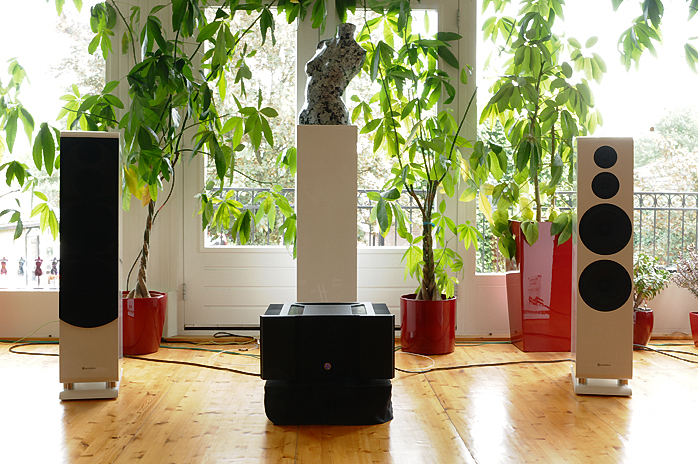This review page is supported in part by the sponsors whose ad banners are displayed below |
 |
 |
|
| At the back the speaker terminals were twinned for biwiring unlike the Alpha F3 version we’d last seen in Warsaw. A set of cable jumpers was provided for single wire use. Sounddeco claim no extravagant parts for their crossover which consists of components that do the job not just to satisfy Greg’s test bench but also a panel of critical listeners. For another Danish touch there are Jantzen Cross Cap capacitors and coils in the filters.
Still on a slippery towel, we positioned the Alpha F3 in a preliminary classic 0.8:1.0 arrangement with the distance between the speakers 2.70 meters and with a slight toe-in aiming at the listening position. For the first sessions we commissioned the Devialet D-Premier hooked to the speakers via Nanotec SP#777 in single-wire configuration. Input was streaming media via the La Rosita Beta’s S/PDIF output; or analog from the Feickert Blackbird in its recently updated state (new electronics, bearing and arm board). |
|
|
|
 |
|
|
|
With plenty of outdoor sunshine, we were in the mood for nothing too heavy musically and compiled a playlist to reflect that mood. Once you know exactly what you want to select, Qobuz Desktop offers plenty of options and amongst others we picked Flavia Coelho’s Mundo Meu, Jesse Cook’s Montreal (live), Gerardo Nuñez’ Travesia and Rupa & The April Fishes’ Este Mundo. This selection varied between Brazilian pop with forro, rap and even ragamuffin influences through rumba flamenco to raga and klezmer. Coincidently or not, all albums covered the same subject of crossing geographical or stylistic boundaries. For a selection of vinyl we turned to our collection of Ry Cooder albums.
|
 |
Like many modern recordings, the Coelho album isn’t an example of exploded dynamic range. Instead the producers enhanced the bass without going overboard. However, the overall loudness is quite high. All its songs rest on a strong low-frequency foundation and the agile voice of Flavia Coelho suits the most varied styles. Played with the Alpha F3 the music invited us to turn up the volume until it was hard to sit still. Sunshine entered the room not just through the windows but also from the speakers. This kind of music with its strong bass offered a nice display for the speaker’s ability to go down. Rated to produce 40Hz at -2.5dB, the speaker was advertised to handle it without turning this music thin. It was only with the Rupa track "Este Mundo" and a huge drum which even taxes a subwoofer that the anticipated effect went missing. On the other hand, this very low blow didn’t cause trouble for the speakers either. There was no sign of break-up or any other negative reaction, just omission of the lowest frequency components.
|
 |
|
|
|
|
A narrow baffle is said to introduce diffraction problems. If so, Sounddeco must have countered any diffraction issues very effectively in their crossover filter. On the other hand a wide baffle will introduce reflections yet in our listening we did not encounter any of these effects either. Our initial setup had the speakers 70cm from the front wall as an estimated starting guess. Further experiments showed that the Alpha F3 was perfectly happy still closer to the wall. No doubt the placement of the bass reflex port at the bottom of the cabinet firing into a fixed plinth for predetermined radiation resistance added to such unfussy placement happiness. We could detect no strong influences on the overall sonic balance regardless of wall proximity. That was noteworthy and eminently practical!
|
 |
When the speakers moved to the shorter room wall, we had more amplifier choices plus the streaming input from the Phasure XXHighEnd/NOS1 combination. Using either our Hypex Ncore 1200 monos or Trafomatic Kaivalya monos, the Alpha F3 was perfectly happy. With room to spare, the speaker setup could be wider or narrower just like the distance to the front wall was more flexible in this orientation. We tried a variety of combinations and they all worked equally well.
|
 |
With the biwiring option at hand, we fetched a set of Nanotec SP#79MK-4 whose nomenclature denotes a biwire. It is not simply a doubling of the conductor pair however but a hybrid version of Nanotec’s standard #79. One pair of leads consists of 7 x 0.5mm OFC conductors surrounded by 26 x 0.18mm OFC equivalents. For each of these pairs, one leg is soaked in a colloidal liquid of 92.5% gold and 7.5% suspended silver particles, the other in 90% gold and 10% silver. Two leads are insulated with PE, the other two with PVC. All four leads are embedded in pure cotton strings followed by Japanese rice paper and a transparent outer PVC tube. The whole assembly is 9.8mm thick and solid but not inflexible.
|
 |
  |
 |